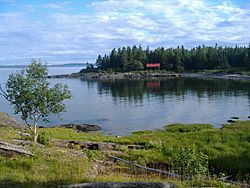Île aux Basques facts for kids
 |
|
| Geography | |
|---|---|
| Location | Saint Lawrence River |
| Coordinates | 48°8′34″N 69°14′58″W / 48.14278°N 69.24944°W |
| Area | 0.55 km2 (0.21 sq mi) |
| Length | 2 km (1.2 mi) |
| Width | 0.4 km (0.25 mi) |
| Administration | |
| Province | Quebec |
| Region | Bas-Saint-Laurent |
| Regional County Municipality | Les Basques |
| Municipality | Notre-Dame-des-Neiges |
Île aux Basques is a Canadian island. It is found in the lower part of the Saint Lawrence River. This is where the river meets the ocean. The island is about 5 kilometers (3 miles) north of Trois-Pistoles, Quebec. It is part of the Quebec region called Bas-Saint-Laurent.
Since 1929, the island has been a special protected area. It is a sanctuary for migratory birds. These are birds that travel long distances. The island is named after the Basques. They were people from a region in Europe. They visited the island often between 1584 and 1637.
Contents
History of Île aux Basques
Why the Basques Came to the Island
The Basques came to the island for two main reasons. First, there was not enough space in their home country. Second, the Saint Lawrence River had many whales. The Basques were skilled fishermen and whalers. Their home region was divided between France and Spain. This happened after a war in 1512.
Many wars and invasions made sailors explore new areas. They traveled further into the Atlantic Ocean. They were looking for seals, porpoises, and whales. The Basques also traded with the Iroquois and Algonquins. Île aux Basques was one of the first places where these cultures met.
Discoveries on the Island
Archaeologists found proof of this history in the 1990s. They dug at different spots on the island. They found sites from both Basque and Native American cultures. Four of these sites are along the southern shore. These places are called "shore camps."
Shore camps were important for fishermen and whalers. They could get fresh water and firewood there. They also used these camps to dry their fish. Whalers used them to process whales. They would turn whale blubber into oil.
Basque Ovens and Artifacts
Archaeologists found four Basque ovens on the island. These ovens were used to make whale oil. Two ovens were found at a spot called l'Anse à la Baleine. The other two were at l'Anse Qui Pue and l'Anse d'En Bas.
Inside one oven at l'Anse à la Baleine, they found burnt blubber. They also found pieces of roof tiles and European dishes. Near the Basque items, they found two glass beads. One bead was turquoise, and the other was white. These beads were like the ones Europeans traded with native peoples.
Native American pottery pieces were also found. Other Basque items were found at different sites. This shows that Basques and native peoples were on the island at the same time.
When the Basques Left
The last time anyone wrote about Basques on the island was in 1637. This was by a Jesuit named Paul Lejeune. We do not know exactly when the Basques stopped visiting. But in 1664, another Jesuit, Father Henri Nouvel, wrote about it. He said the Basque presence on the island was "a thing of the past."
He wrote, "It [the island] goes by the name of the Isle aux Basques. This is because of the whaling the Basques did there long ago. I liked visiting the big ovens they built to make their oil. We can still see the huge ribs of Whales they killed."
Island Facts and Protection
Size and Location
The island is about 2 kilometers (1.2 miles) long. It is 400 meters (1,300 feet) wide. Its total area is 0.55 square kilometers (0.21 square miles). The highest point on the island is 50 meters (164 feet) high. This point is in the center of the island.
Île aux Basques is part of the Appalachia region. It is on the south side of the St. Lawrence River. It is across from the city of Trois-Pistoles. The island is about 250 kilometers (155 miles) east of Quebec City.
National Historic Site
Île aux Basques has been named a National Historic Site of Canada. This means it is a very important place in Canadian history.
See also
 In Spanish: Île aux Basques para niños
In Spanish: Île aux Basques para niños

